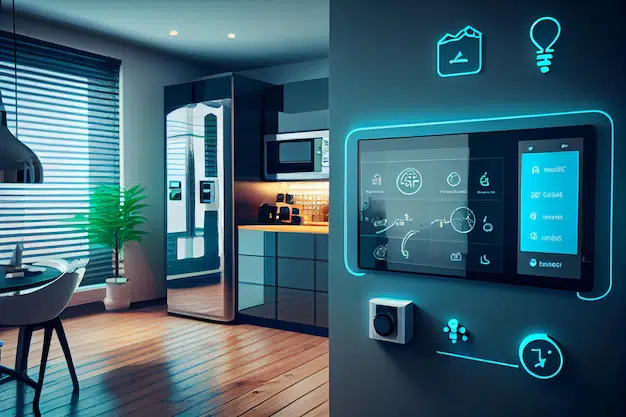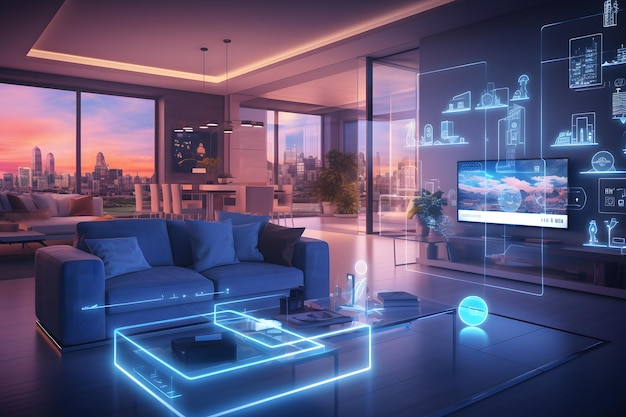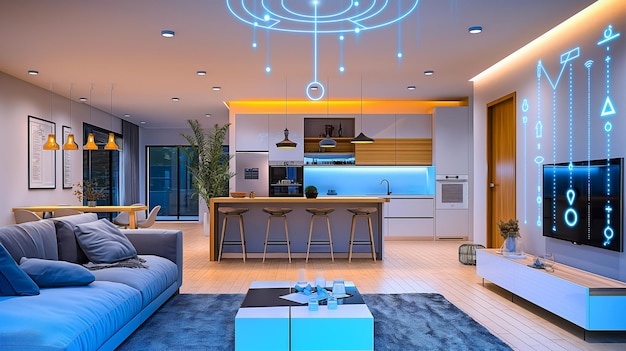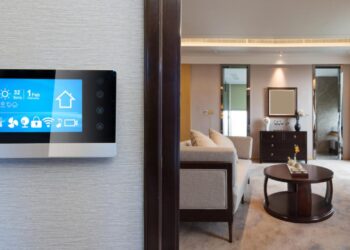The concept of a home has transcended its traditional role as a mere shelter. Driven by relentless technological innovation, residences are now evolving into sophisticated, interconnected environments where every aspect, from illumination to entertainment, is seamlessly managed and intelligently optimized. This profound transformation, dubbed the Tech-Integrated Home Evolution, represents a shift from simple automation to truly intelligent living spaces that anticipate needs, enhance security, prioritize well-being, and fundamentally redefine our daily domestic experience. It’s a journey where convenience meets cutting-edge technology, creating living environments that are as intuitive as they are innovative.
Why Homes Are Becoming Tech Hubs

The accelerated integration of technology into our homes isn’t a random occurrence; it’s a direct outcome of several powerful trends and societal demands. Understanding these catalysts helps us grasp the profound impact of this ongoing evolution.
A. Rapid Technological Advancements:
A. Ubiquitous Connectivity: The proliferation of high-speed internet, Wi-Fi 6, 5G, and advanced Bluetooth standards provides a robust, low-latency backbone for countless connected devices. This pervasive connectivity is the fundamental enabler of the smart home ecosystem.
B. Miniaturization and Affordability: Sensors, microprocessors, and cameras have become incredibly small, powerful, and cost-effective. This allows for their integration into a vast array of everyday objects, making smart technology accessible to a wider consumer base.
C. Artificial Intelligence (AI) and Machine Learning (ML): These sophisticated algorithms empower smart devices to learn from user behavior, analyze data patterns, and make autonomous decisions. AI allows systems to anticipate needs, personalize experiences, and optimize performance over time, moving beyond simple programmed commands.
D. Voice Assistants: The widespread adoption of voice-controlled platforms (e.g., Alexa, Google Assistant, Siri) has normalized conversational interaction with technology, making smart home control intuitive and hands-free for millions.
B. The Pursuit of Convenience and Comfort:
A. Automated Routines: Modern life is increasingly busy. Tech-integrated homes simplify daily chores by automating tasks such as adjusting thermostats, turning lights on/off, brewing coffee, or even managing home security, freeing up valuable time and mental energy.
B. Personalized Environments: The ability to tailor lighting, temperature, music, and even scents to individual preferences or moods creates an unparalleled level of comfort. Homes can proactively adjust based on time of day, occupancy, or even biometric data.
C. Remote Management: Controlling home systems from anywhere in the world via a smartphone app offers immense peace of mind and flexibility, whether it’s checking on pets, adjusting heating before returning home, or ensuring doors are locked.
C. Enhanced Security and Safety:
A. Proactive Monitoring: Smart security systems offer more than just alarms. They provide remote video surveillance, motion detection, intelligent alerts for unusual activity, and smart locks that can be controlled and monitored from afar.
B. Early Hazard Detection: Integrated smart sensors can detect subtle issues like water leaks, smoke, carbon monoxide, or even unusual sounds, providing early warnings that can prevent significant damage or save lives.
C. Deterrence: Visible smart cameras, doorbell cameras, and automated lighting can act as significant deterrents to potential intruders, enhancing overall safety.
D. Energy Efficiency and Sustainability:
A. Optimized Resource Consumption: Smart thermostats, lighting, and appliance managers can significantly reduce energy waste by learning usage patterns and automatically adjusting settings (e.g., turning off lights in empty rooms, optimizing HVAC schedules).
B. Reduced Carbon Footprint: By minimizing energy and water consumption, tech-integrated homes contribute to a lower environmental impact, appealing to environmentally conscious consumers and reducing utility bills.
C. Integration with Renewables: Smart home systems can seamlessly manage energy flow from solar panels and battery storage, optimizing self-consumption and reducing reliance on grid power.
E. Accessibility and Inclusivity:
A. Empowering Independent Living: For the elderly or individuals with disabilities, smart home technology offers transformative accessibility. Voice control, automated door locks, smart lighting, and remote monitoring enable greater independence and safety, allowing more people to age in place comfortably.
B. Customizable Interfaces: Users can choose their preferred method of interaction, whether it’s voice, touch screens, apps, or even gesture control, accommodating various needs.
F. Elevated Entertainment and Lifestyle:
A. Immersive Media Experiences: Integrated smart TVs, multi-room audio systems, and automated lighting create cinematic or concert-like experiences within the home.
B. Connected Health and Wellness: Smart mirrors, fitness equipment that integrates with home ecosystems, and even smart beds can monitor health metrics and support wellness routines.
C. Culinary Innovation: Smart kitchen appliances offer recipe guidance, remote preheating, and inventory management, transforming the cooking experience.
Key Components of Tech-Integrated Homes

A truly tech-integrated home is not a collection of isolated gadgets; it’s a cohesive system where devices communicate and cooperate, orchestrated by central intelligence.
A. The Central Nervous System
At the heart of the integrated home lies the control system that orchestrates all connected devices.
A. Smart Hubs/Gateways: Dedicated devices (e.g., Amazon Echo, Google Nest Hub, Apple HomePod, Samsung SmartThings Hub, Hubitat) act as central controllers. They often support multiple communication protocols (Wi-Fi, Bluetooth, Zigbee, Z-Wave, Thread) allowing devices from different manufacturers to communicate.
B. Voice Assistants: Integrated into hubs, smart speakers, and even TVs, voice assistants provide the most intuitive, hands-free control interface, allowing users to command their home naturally.
C. Smartphone/Tablet Apps: These serve as the primary visual interface for setup, monitoring, and remote control of the entire system, offering granular control and customization.
D. Universal Remotes/Touchscreens: Dedicated wall-mounted touchscreens or advanced universal remotes can offer a centralized control point, particularly in more complex systems.
B. Intelligent Climate and Environmental Management
Beyond basic thermostats, these systems create truly responsive comfort.
A. Smart Thermostats: Devices like Nest or Ecobee learn user preferences, adjust settings based on occupancy, weather forecasts, and schedules, and can be remotely controlled. They often provide detailed energy consumption reports.
B. Smart Vents and Zone Control: Allows for precise temperature regulation in individual rooms or zones, preventing wasted heating/cooling in unoccupied areas.
C. Smart Fans: Automatically adjust speed based on temperature and humidity, or integrate with other systems.
D. Air Quality Monitors & Purifiers: Sensors detect pollutants (VOCs, particulate matter, CO2) and trigger integrated air purifiers or ventilation systems when needed, ensuring healthy indoor air.
E. Smart Blinds/Shades: Automatically adjust based on sunlight, temperature, or privacy settings, optimizing natural light, reducing glare, and contributing to thermal efficiency.
C. Advanced Lighting Systems
More than just illumination, smart lighting sets mood, enhances security, and saves energy.
A. Smart Bulbs: Individually controllable bulbs (Wi-Fi or Bluetooth enabled) offering dimming, color changing (RGBW), and scheduling. They can be grouped and synchronized.
B. Smart Switches/Dimmers: Control existing “dumb” fixtures, converting them into smart lights, often preferred for maintaining traditional wall switch aesthetics.
C. Motion/Occupancy Sensors: Automate lights turning on/off based on presence, particularly useful in hallways, bathrooms, and utility areas for convenience and energy savings.
D. Circadian Lighting: Advanced systems that mimic natural sunlight cycles, gradually changing color temperature and brightness throughout the day to support healthy sleep-wake patterns and alertness.
E. Outdoor Lighting Control: Automated lighting for security, pathways, and landscaping, often integrated with dusk-to-dawn sensors or motion detection.
D. Comprehensive Security and Surveillance
Peace of mind through vigilant, connected protection.
A. Smart Locks: Keyless entry via keypad, fingerprint, smartphone app, or even voice. Features include remote locking/unlocking, temporary access codes for visitors, and activity logs.
B. Security Cameras: Indoor and outdoor cameras with high-definition video, night vision, motion detection, two-way audio, and cloud storage. Advanced features include facial recognition, pet detection, and package delivery alerts.
C. Video Doorbells: Allow homeowners to see, hear, and speak to visitors from anywhere, receiving notifications when someone approaches or rings the bell.
D. Window/Door Sensors: Detect unauthorized entry by sensing opening or vibration, triggering alarms or alerts.
E. Integrated Alarm Systems: Professionally monitored or self-monitored systems that combine various sensors (motion, glass break, flood) with sirens and direct alerts to homeowners or emergency services.
F. Leak Detectors: Sensors placed near water heaters, sinks, or washing machines detect water leaks, sending alerts and potentially triggering automatic water shut-off valves to prevent catastrophic damage.
E. Smart Appliances and Kitchen Tech
Bringing intelligence to everyday household tasks.
A. Smart Refrigerators: Features include internal cameras to view contents remotely, interactive touchscreens for calendars/notes, ingredient tracking, and even recipe suggestions.
B. Smart Ovens/Cooktops: Remote preheating, guided cooking programs, integration with smart recipe apps, and safety features like automatic shut-off.
C. Smart Washing Machines/Dryers: Remote cycle starting, notifications when laundry is done, optimized cycles for energy efficiency, and automatic detergent dispensing.
D. Robot Vacuums/Mops: Automated floor cleaning with advanced mapping capabilities, obstacle avoidance, and scheduling. Some models offer self-emptying and self-washing bases.
E. Smart Coffee Makers: Brew on a schedule or command, with personalized settings.
F. Immersive Entertainment and Media Systems
Transforming living spaces into dynamic entertainment zones.
A. Smart TVs and Streaming Devices: Integrated with voice assistants, app stores, and capable of connecting to other smart home devices.
B. Multi-Room Audio Systems: Smart speakers (e.g., Sonos, Google Home, Amazon Echo) that can be grouped for synchronized audio throughout the house or play different content in different rooms.
C. Home Theater Integration: Automated control of projectors, screens, surround sound systems, and lighting to create cinematic experiences at the touch of a button.
D. Smart Mirrors: Beyond reflection, these offer integrated displays for news, weather, health stats, workout routines, or streaming content.
Advanced Capabilities and Future Trajectories
The evolution of tech-integrated homes is continuous, with cutting-edge innovations constantly pushing the boundaries of what’s possible.
A. Predictive Intelligence and Personalization
Moving from reactive control to proactive anticipation of needs.
A. Adaptive Learning Algorithms: AI systems continuously learn from user habits, environmental conditions, and external data (e.g., weather, traffic, utility pricing) to make autonomous, optimized decisions without explicit commands. For example, a home might learn your preferred wake-up routine and gradually adjust lights, temperature, and music.
B. Contextual Awareness: Homes will understand context – whether you’re alone or with guests, working or relaxing, sleeping or awake – and adapt accordingly. This could involve recognizing individual family members through facial or voice recognition and personalizing their experience.
C. Emotional and Wellness Integration: Future homes might monitor subtle biometric cues (e.g., heart rate from a smart bed, voice tone) to detect stress or discomfort and adjust the environment (lighting, soundscapes, temperature, scent diffusers) to promote relaxation or boost energy.
B. Energy Autonomy and Microgrids
Homes will become even more self-sufficient and interact intelligently with the broader energy grid.
A. Smart Grid Integration: Homes will dynamically interact with the smart grid, optimizing energy consumption based on real-time electricity prices, demand fluctuations, and renewable energy availability. They might automatically charge electric vehicles during off-peak hours or sell excess solar power back to the grid.
B. Advanced Battery Storage: Sophisticated home battery systems (e.g., Tesla Powerwall) will seamlessly manage energy from solar panels, store excess, and provide backup power during outages, promoting energy independence.
C. Net-Zero/Positive Energy Homes: Designs and technologies aiming for homes that produce as much or more energy than they consume, significantly reducing their carbon footprint. This often involves a combination of highly efficient envelopes, on-site renewables, and smart energy management.
C. Seamless Interoperability and Standardized Protocols
Addressing the current fragmentation of the smart home market.
A. Matter and Thread: Newer, open-source communication protocols like Matter aim to provide universal compatibility, allowing devices from different manufacturers to communicate effortlessly. Thread is a low-power, mesh networking protocol that enhances reliability and speed for smart home devices.
B. Edge Computing: More processing power will reside directly on smart devices, reducing reliance on cloud servers, improving response times, enhancing data privacy, and allowing devices to function even during internet outages.
D. Advanced Robotics and Automation
Beyond fixed appliances, the home will see more mobile, intelligent assistants.
A. Personal Assistant Robots: Mobile robots that can navigate the home, offer companionship, remind residents of appointments, assist with minor chores, or even provide security patrols.
B. Automated Maintenance: Robots that can inspect pipes for leaks, clean gutters, or perform basic outdoor maintenance.
C. Smart Garden/Yard Care: Automated irrigation systems that adjust based on weather and soil moisture, robotic lawnmowers, and sensors that monitor plant health.
E. Augmented and Virtual Reality Integration
Blurring the lines between the physical and digital living space.
A. AR for Interior Design: Future homeowners could use AR glasses to virtually redecorate, rearrange furniture, or test different color schemes in real-time before making physical changes.
B. Virtual Entertainment: Immersive VR experiences for gaming, movies, or even virtual travel could be seamlessly integrated into living rooms.
C. Digital Overlays: Information or interactive elements projected onto surfaces (walls, tables) to create dynamic interfaces without dedicated screens.
F. Health and Medical Integration
Homes becoming active partners in health management and elder care.
A. Passive Health Monitoring: Sensors embedded in furniture, flooring, or clothing could passively monitor vital signs, sleep patterns, gait changes (indicating fall risk), or even subtle behavioral shifts, alerting caregivers to potential health issues.
B. Medication Management: Smart dispensers that remind users to take medication and track adherence.
C. Telehealth Enablement: Seamless integration of video conferencing tools and medical devices for remote consultations with healthcare professionals.
D. Emergency Response Systems: Automated fall detection, panic buttons, and direct connections to emergency services for rapid assistance.
Challenges and Considerations for the Tech-Integrated Home
While the vision is compelling, the journey to a fully integrated home comes with its own set of hurdles and critical considerations.
A. Data Privacy and Security: The collection of vast amounts of personal data (habits, voice commands, video feeds) by smart devices raises significant privacy concerns. Robust encryption, secure data storage, and transparent privacy policies are paramount. Devices can also be vulnerable to cyberattacks if not properly secured.
B. Interoperability and Fragmentation: Despite efforts, the smart home market is still somewhat fragmented, with devices from different brands sometimes struggling to communicate seamlessly. This can lead to frustration and limit functionality.
C. Complexity and User Experience: While designed for convenience, setting up, configuring, and troubleshooting complex smart home ecosystems can be daunting for non-tech-savvy users. A clunky interface or unreliable connectivity can quickly diminish perceived value.
D. Cost of Entry and Maintenance: While individual devices are increasingly affordable, building a comprehensive, high-end tech-integrated home can still be a significant investment. Ongoing maintenance, software updates, and potential hardware upgrades also represent long-term costs.
E. Reliance on Internet Connectivity: Many advanced smart home features are dependent on a stable, high-speed internet connection. Outages can render systems inoperable, reducing smart capabilities to “dumb” functionality.
F. Planned Obsolescence and Support: The rapid pace of technological change means that smart devices can become obsolete quickly. Long-term software support, firmware updates, and the availability of replacement parts are crucial for sustainability and longevity.
G. Ethical Considerations: Questions arise around surveillance, data misuse, potential biases in AI, and the impact on human autonomy as homes become more intelligent.
H. Digital Divide: Ensuring equitable access to tech-integrated living is important to prevent a new form of societal disparity, where advanced home technologies are only available to the affluent.
Conclusion
The Tech-Integrated Home Evolution is not a distant concept; it’s happening all around us, transforming how we live, work, and interact with our personal spaces. As technology continues its relentless march forward, pushing the boundaries of what is possible, our homes will increasingly become intuitive partners in our daily lives.
This evolution is about more than just convenience or novelty. It’s about creating living environments that are healthier, safer, more energy-efficient, and profoundly personalized. It’s about empowering individuals with greater control and insight into their surroundings, freeing up mental bandwidth, and fostering a sense of seamless well-being. While challenges remain, the clear trajectory is towards homes that are not just smart, but truly intelligent – spaces that understand us, adapt to us, and enrich our lives in ways we are only just beginning to fully comprehend. The integration of technology into our homes is fundamentally redefining what “living” means in the modern age, making our domestic environments more responsive, efficient, and ultimately, more alive.









